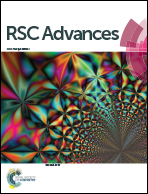Towards understanding the stability of the N5+-containing salts: the role of counterions†
Abstract
The thermal stabilities of the N5+M− species (M = Sb(OH)6, Sb(OH)4F2, AlF6, AlF4, BF4, B(CF3)4, PF6, AsF6 and SbF6) have been studied by means of density functional theory. The present calculations indicate that their thermal stabilities (represented by activation enthalpy, ΔH≠ in kcal mol−1) decrease in the order N5+ (47.2) > N5B(CF3)4 (34.1) ≈ N5SbF6 (31.6) ≈ N5AsF6 (31.5) > N5PF6 (30.5) > N5AlF4 (27.1) ≈ N5BF4 (27.1) > N5AlF6 (8.5). Only N5SbF6 has a small positive reaction enthalpy, ΔrH. The thermal stability of the N5+ salt depends on the amount of electron transfer from the counterion to N5+ in the reaction. The high electronegativite atoms or groups in the counterion are essential. Another crucial factor is bond strength between the central ion and the ligand. Studies of the N5Sb(OH)4F2 isomers indicate that the OH rather than the fluorine ions in the axial coordination positions could stabilize the decomposition transition structure through partial dissociation of the Sb–OH bond, which is used to explain the reason why there is an obvious difference in the decomposition activation enthalpies of the three isomers.


 Please wait while we load your content...
Please wait while we load your content...